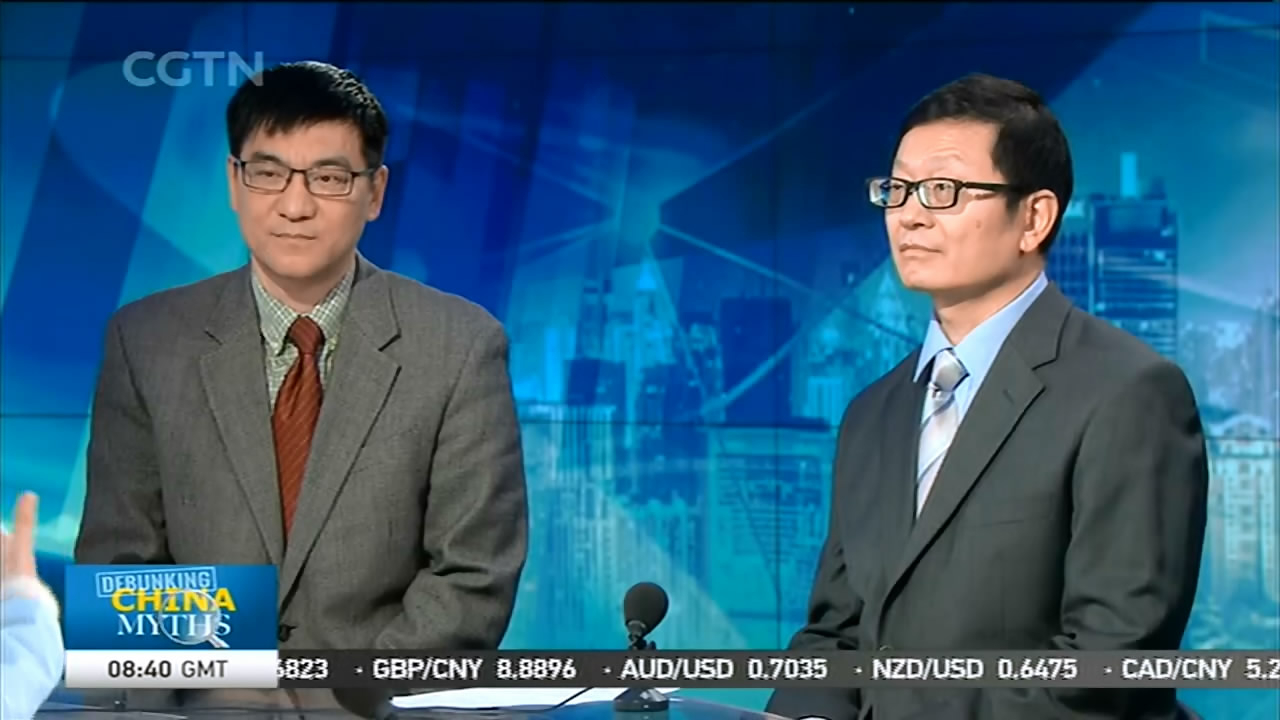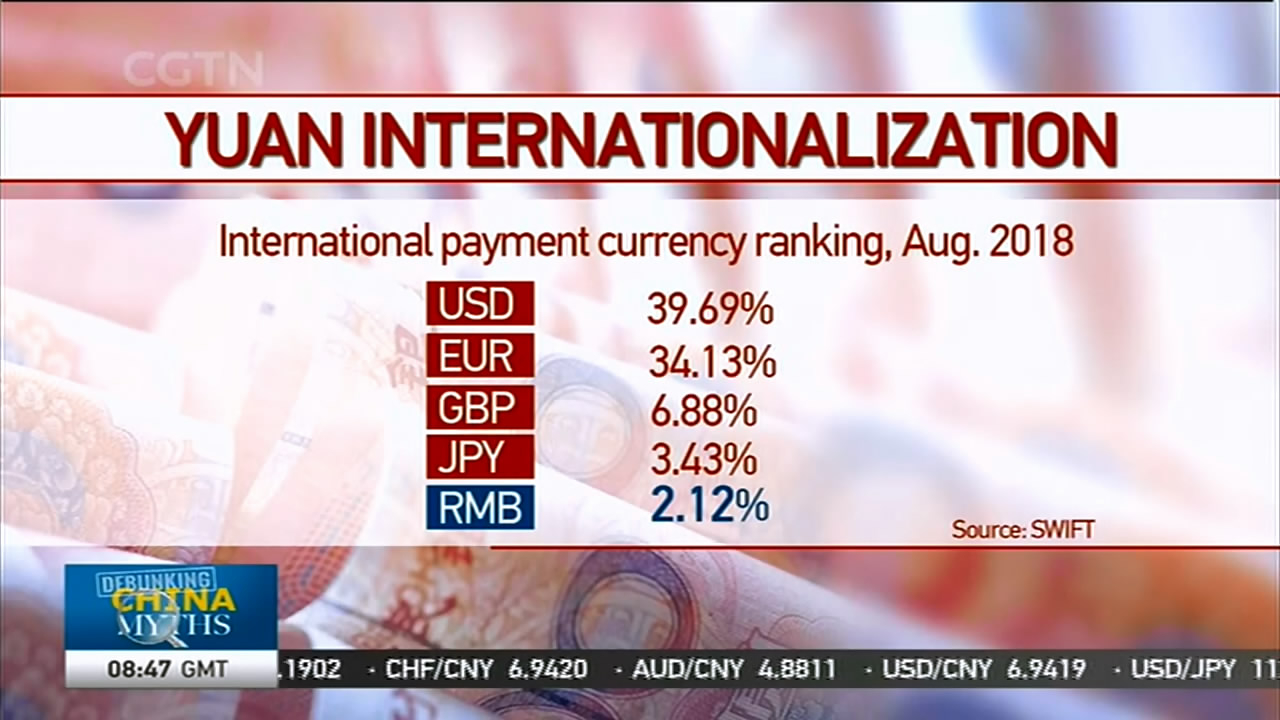
Business
13:46, 28-Oct-2018
Debunking China Myths: Is a weaker but more internationalized RMB on the way?
Updated
13:33, 31-Oct-2018
By CGTN’s Wang Yue
04:29

The Chinese yuan has fallen over six percent against the US dollar so far this year, approaching the psychologically important level of seven to the dollar.
01:58

Is RMB on the path to break the seven mark soon?
China's central bank set the midpoint rate at 6.9510 per US dollar on Friday, slightly weaker than Thursday's fix at 6.9409. That came after the offshore yuan depreciated beyond 6.97 per US dollar, falling to its weakest level since January 2017.
"I think we are going to hit that sooner or later. I think in the long run, the trend is that we will continue to see RMB getting weaker," said John Gong, a professor at the University of International Business and Economics.
"The weakening of RMB would continue," Wang Jianhui, general manager at R&D department of Capital Securities, said, sharing the same opinion.
According to the experts, the major factors behind the yuan depreciation are escalating trade frictions between China and the US, and the Federal Reserve's frequent interest rate hikes.

CGTN Screenshot
CGTN Screenshot
In fact, the country has implemented several policies this year to stabilize the yuan amid uncertainties.
In August, the People's Bank of China (PBOC) adjusted the foreign exchange risk reserve requirement ratio to 20 percent, then resumed using the counter-cyclical factor in the yuan midpoint-fixing mechanism.
Wang appreciated the PBOC's work in keeping a tight grip on the yuan while making the currency more free and market oriented. But the analyst rejected the opinion that the PBOC will move aggressively to protect the yuan.
"On the one hand, [PBOC] wants to save some heavy weapons for later, harder time. On the other hand, PBOC now is paying more attention to stabilizing the economy. So instead of focusing on the exchange rate, the PBOC will more likely leave the exchange rate fluctuating based on market orientation," Wang elaborated.
02:16

How big of a concern is capital outflow?
Spokesperson for China's State Administration of Foreign Exchange, Wang Chunying, said Chinese cross-border capital flow has remained stable despite global trade uncertainties.
But experts are also concerned about the capital out-flight. "It's clear that there is money moving out," Gong viewed.
"Over the next few years, people will be concerned that RMB continues to devaluate. Additionally, there is less confidence in the investment environment. People think that the economy is not going to do as well as we would like to see," he added.

CGTN Screenshot
CGTN Screenshot
"If you look at the trade data, we have a roughly 20-30 billion US dollars per month from the trade surplus. But in the meantime, we are also losing money from the banking system. So we have a kind of deficit between the bank sale and the purchase of foreign currencies. The deficit is around 17-20 billion US dollars for months," Wang indicated.
Gong further explained, "Also we have seen some reduction of foreign currency saving deposits in the banking system. That deposits dropped by about 23 billion US dollars last month. So combining the two things, we might suspect that the capital outflow may range between 30-40 billion US dollars per month."
"Money is always chasing for opportunities. In today's world, it is actually quite easy to move money around. And our government has some sort of control regime. But it is kind of difficult to prevent things from happening," Gong noted.
The professor also warned that "Our foreign exchange reserve is shrinking... We are probably seeing more assets moving out of the country. And that explained why RMB is under a lot of pressure."
03:48

Will a more internationally welcomed RMB challenge a US dollar-dominated system?
China has also been striving to internationalize its yuan in addition to implementing exchange rate reforms and stabilizing the Chinese currency. October marks the second anniversary of the yuan's inclusion in the basket of the IMF's Special Drawing Rights. More than 60 countries and regions now use the yuan as a reserve currency.
Fresh data showed that the yuan was ranked fifth as an international payment currency, accounting for 1.89 percent of the value of institutional and commercial payments in September.
But analysts said the yuan's internationalization is still in its early stage, and the currency has a long way to go to compete with the US dollar, the euro, the British pound and the Japanese yen.

CGTN Screenshot
CGTN Screenshot
According to Gong, the total international trade denominated in yuan might just be equivalent to six percent of US dollar's.
"The scale is quite small," Gong commented. In the meantime, he considered the US calling for the yuan's full convertibility lip service. "They don't want any currency to challenge the status of US dollar."
Wang defined the internationalization of yuan as a supplement to the current system.
"Adding RMB into the international family will help reduce the systemic risks both financially and politically... I don't think this process will harm other currencies," he maintained.
Meanwhile, Professor Gong expressed concern that internationalizing the yuan too fast might bring a huge risk to the financial system.
"It's not just about currency issue. I think when you have a currency fully convertible and totally internationalized, the financial market has to be also obviously opened, which means capital can move in and out freely. And that imposes a huge risk to the financial system. I don't think our system is ready for that kind of capital movement right now," Gong reminded.
Gong advised a thorough reform on the financial system before a fully convertible yuan.
"We need to introduce a whole reform of the financial system before we can really talk about 100 percent fully convertible RMB. This has to do with the fundamental economic system. It's not going to be easy," he emphasized.

SITEMAP
Copyright © 2018 CGTN. Beijing ICP prepared NO.16065310-3
Copyright © 2018 CGTN. Beijing ICP prepared NO.16065310-3